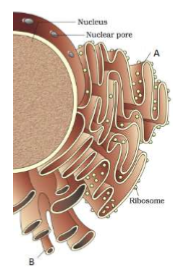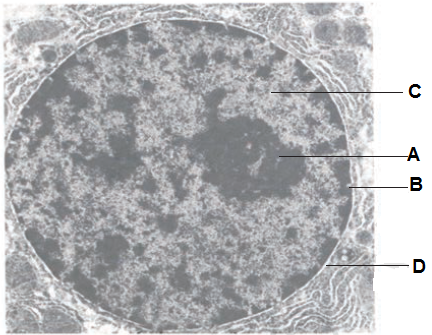Question: From NCERT NEET Derived PYQ
Which of the following is the largest constituent of the membrane of the
erythrocyte in human beings and is also responsible for performing most of the functions of the membrane?
1.Proteins
2.Lipids
3.Glycolipids
4.Glycoproteins
Answer ▽
2.Lipids
- Erythrocytes are also known as RBC. It takes oxygen from the lungs and transport to the whole body.
- The cytoplasm of erythrocytes is rich in hemoglobin, which is iron-containing biomolecules.
- The membrane of RBC is composed of proteins and lipids. It contains approximately 40% of proteins and 52% lipid. The remaining 8% is composed of oligosaccharides
⬆️Prev____@organised notes_____Next⬇️
Question: From NCERT NEET Derived PYQ
Answer ▽
- Erythrocytes are also known as RBC. It takes oxygen from the lungs and transport to the whole body.
- The cytoplasm of erythrocytes is rich in hemoglobin, which is iron-containing biomolecules.
- The membrane of RBC is composed of proteins and lipids. It contains approximately 40% of proteins and 52%. The remaining 8% is composed of oligosaccharides
⬆️Prev____@organised notes_____Next⬇️
Question: From NCERT NEET Derived PYQ
Answer ▽
Human erythrocytes or RBCs have a shape of disc that appears to be 'caved in' or almost flattened in the middle. This biconcave shape allows RBCs to bend and flow smoothly through the narrowest blood vessels in the body. Mammalian cells are enucleated in their mature form. They are small and round in shape.
Thus, the correct answer is option C.
⬆️Prev____@organised notes_____Next⬇️
Question: From NCERT NEET Derived PYQ
Answer ▽
Neutrophils are known as micropolice of blood because of their phagocytotic nature. They engulf the foreign particles and digest them. Their number increases upon bacterial infection. Hence, the correct answer is option A.
⬆️Prev____@organised notes_____Next⬇️
Question: From NCERT NEET Derived PYQ
Who concluded, based on his studies on plant tissues, that the presence of cell wall is a unique character of plant cells ?
(1) Mathias Schleiden
(2) Theodore Schwann
(3) Rudolph Virchow
(4) Robert Hooke
Answer ▽
2
⬆️Prev____@organised notes_____Next⬇️
Question: From NCERT NEET Derived PYQ
The outer membrane of the nucleus:
I. is continuous with the Endoplasmic reticulum
II. does not bear ribosomes.
1. Only I is correct
2. Only II is correct
3. Both I and II are correct
4. Both I and II are incorrect
Answer ▽
1
⬆️Prev____@organised notes_____Next⬇️
Question: From NCERT NEET Derived PYQ
If the centromere is situated close to the end of a chromosome, it is called as:
1. Metacentric
2. Submetacentric
3. Acrocentric
4. Telocentric
Answer ▽
3
⬆️Prev____@organised notes_____Next⬇️
Question: From NCERT NEET Derived PYQ
Prokaryotic cells have something unique in the form of:
1. Inclusion bodies
2. Plasmids
3. Cell wall
4. 70 S ribosomes
Answer ▽
1
⬆️Prev____@organised notes_____Next⬇️
Question: From NCERT NEET Derived PYQ
Ribosomes are produced in
1. Nucleolus
2. Mitochondria
3. Cytoplasm
4. Golgibody
Answer ▽
1
⬆️Prev____@organised notes_____Next⬇️
Question: From NCERT NEET Derived PYQ
A feature unique to prokaryotes would be:
1. A cell wall not made up of cellulose
2. An extrachromosomal plasmid DNA
3. A cell membrane of peptidoglycan
4. Presence of inclusions
Answer ▽
4
⬆️Prev____@organised notes_____Next⬇️
Question: From NCERT NEET Derived PYQ
Chromatophores are:
1. present in liopolysaccharide layer of gram negative bacteria
2. colored pigments present in fluorescent bacteria
3. vesicles that store pigments in prokaryotic cells
4. extensions on membrane in cynobacteria
Answer ▽
4
In some forms of photosynthetic bacteria, a chromatophore is a coloured, membrane-associated vesicle used to perform photosynthesis. ... They contain different coloured pigments. Chromatophores contain bacteriochlorophyll pigments and carotenoids.
⬆️Prev____@organised notes_____Next⬇️
Question: From NCERT NEET Derived PYQ
The tail of the phospholipid molecule:
1. is hydrophilic and composed of phosphate
2. is hydrophilic and composed of saturated hydrocarbons
3. is hydrophobic and composed of saturated hydrocarbons
4. is hydrophobic and composed of unsaturated hydrocarbons
Answer ▽
3
⬆️Prev____@organised notes_____Next⬇️
Question: From NCERT NEET Derived PYQ
Fat soluble pigments like xanthophylls are present in:
1. Chromoplasts
2. Aleuroplasts
3. Elaioplasts
4. Amyloplasts
Answer ▽
1
⬆️Prev____@organised notes_____Next⬇️
Question: From NCERT NEET Derived PYQ
In the given diagram, what is true for both A and B?

1. They are involved in protein synthesis
2. They synthesize steroidal hormones in animal cells
3. They are a part of endomembranous system of a eukaryotic cell
4. They are continuous with the inner membrane of the nucleus
Answer ▽
3
⬆️Prev____@organised notes_____Next⬇️
Question: From NCERT NEET 2015 Derived PYQ
The chromosomes in which centromere is situated close to one end are
1. metacentric
2. acrocentric
3. telocentric
4. sub-metacentric
Answer ▽
2
⬆️Prev____@organised notes_____Next⬇️
Question: From NCERT NEET Derived PYQ AIIMS - 2015
Which one of the following structure is an organelle within an organelle?
(1) Ribosome
(2) Peroxysome
(3) ER
(4) Mesosome
Answer ▽
The ribosomes are the cell organelle that is present inside the other cell organelles like endoplasmic reticulum, mitochondria, and chloroplast. They are known as an organelle within an organelle.
In the 1950s with the help of the electron microscope the Romanian-American George Amil Palade first discovered the ribosomes.
⬆️Prev____@organised notes_____Next⬇️
Question: From NCERT NEET Derived PYQ
Arrange the following in the increasing of their size
(1)virus< PPLO< typical bacteria< typical eukaryotic cell
(2) PPLO< virus< typical bacteria< typical eukaryotic cell
(3) virus< PPLO< typical eukaryotic cell< typical bacteria
(4) virus> PPLO> typical bacteria> typical eukaryotic cell
Answer ▽
1
⬆️Prev____@organised notes_____Next⬇️
Question: From NCERT NEET Derived PYQ
In membranes, the lipids are arranged within the membrane with the ______heads towards the outer sides and the _________ tails towards the inner part.
(1)polar, charged
(2)polar, hydrophobic
(3)polar, nonpolar
(4)Both B and C
Answer ▽
(4)Both B and C
In lipid bilayer, lipids are arranged with the polar head towards the outer side and the hydrophobic/ non-polar tails towards the inner side.
⬆️Prev____@organised notes_____Next⬇️
Question: From NCERT NEET Derived PYQ
Answer ▽
Membrane lipids are amphipathic, that is they possess both polar hydrophilic heads and nonpolar hydrophobic tails.
So, the correct answer is 'Amphipathic'
⬆️Prev____@organised notes_____Next⬇️
Question: From NCERT NEET Derived PYQ
Which one is true for the cell membrane
(1)The ratio of lipids and proteins is fixed in membranes
(2)The amount of carbohydrates is greater than other biomolecules
(3)In human erythrocytes amount of protein is more than that of lipids
(4)All of the above
Answer ▽
3
⬆️Prev____@organised notes_____Next⬇️
Question: From NCERT NEET Derived PYQ
The common component between the cell wall of algae and plants is
(1)cellulose
(2)Hemicellulose
(3)Both A and B
(4)Mannans
Answer ▽
1
⬆️Prev____@organised notes_____Next⬇️
Question: From NCERT NEET Derived PYQ
Which of the following is true about ribosome except
(1)site of protein synthesis
(2)universal cell organelle
(3)70s is present only in prokaryotes
(4)80s is present in eukaryotes
Answer ▽
3
⬆️Prev____@organised notes_____Next⬇️
Question: From NCERT NEET Derived PYQ
Bacteria store their reserved food materials in
(1)Vacuoles
(2)Inclusion bodies
(3)Both A and B
(4)Sphaerosomes
Answer ▽
(2)Inclusion bodies
⬆️Prev____@organised notes_____Next⬇️
Question: From NCERT NEET Derived PYQ
Cytoskeleton is made up of
(1)Proteins
(2)carbohydrates
(3)lipids
(4)All of these
Answer ▽
(1)Proteins
⬆️Prev____@organised notes_____Next⬇️
Question: From NCERT NEET Derived PYQ
Cilia and flagella are
(1)microtubule
(2)microfilament
(3)intermediate filament
(4)Both A and B
Answer ▽
(1)microtubule
⬆️Prev____@organised notes_____Next⬇️
Question: From NCERT NEET Derived PYQ
How many of the following structures are synthesised by microtubules?
Centrioles, basal body, cilia, flagella, spindle fibres
(1)5
(2)4
(3)3
(4)2
Answer ▽
(1)5
Microtubule is structural component of spindle fiber, cilia, flagella, centriole etc.
⬆️Prev____@organised notes_____Next⬇️
Question: From NCERT NEET Derived PYQ
Which of the following is the structural and functional unit of bacterial flagella and cilia
(1)axon
(2)axoneme
(3)flagellin
(4)All of the above
Answer ▽
(2)axoneme
Cilia and flagella are hair-like outgrowths of the cell membrane. Cilia are small structures working like oars, causing the movement of either the cell or the surrounding fluid. Flagella in comparison are longer and responsible for cell movement. Both cilium and flagellum are covered with plasma membrane. Their core called axoneme, possesses a number of microtubules running parallel to the long axis.
⬆️Prev____@organised notes_____Next⬇️
Question: From NCERT NEET Derived PYQ
Answer ▽
Cilia and flagella are hair-like outgrowths of the cell membrane. Cilia are small structures working like oars, causing the movement of either the cell or the surrounding fluid. Flagella in comparison are longer and responsible for cell movement. Both cilium and flagellum are covered with plasma membrane. Their core called axoneme, possesses a number of microtubules running parallel to the long axis.
So, the correct answer is 'All of the above'.
⬆️Prev____@organised notes_____Next⬇️
Question: From NCERT NEET Derived PYQ
Answer ▽
Correct option is B)
Cilium is an organelle found in eukaryotic cells and are hair-like appendages. Inside cilia, is a microtubule-based cytoskeleton called the axoneme. The axoneme of cilia has a ring of nine outer microtubule doublets and two central microtubule singlets in addition to the nine outer doublets, called 9+2 axoneme.
The organized beating of cilia, however, are produced by controlled sliding of outer doublet microtubules.
⬆️Prev____@organised notes_____Next⬇️
Question: From NCERT NEET Derived PYQ
The arrangement of peripheral microtubule in centrioles is
(1)9 as triplets
(2)9 as doublets
(3)9 as singlet
(4)Both A and B
Answer ▽
1
⬆️Prev____@organised notes_____Next⬇️
Question: From NCERT NEET Derived PYQ
Which of the following vacuole is present in photosynthetic bacteria
(1)Food vacuole
(2)Gas vacuole
(3)Contractile vacuole
(4)Sap vacuole
Answer ▽
2
⬆️Prev____@organised notes_____Next⬇️
Question: From NCERT NEET Derived PYQ
Materials to be packaged in the form of vesicles from the ER fuse with the _______ of the Golgi body and after packaging leaves from the ______face.
(1)cis, trans
(2)trans, cis
(3)convex, concave
(4)Both A and C
Answer ▽
4
⬆️Prev____@organised notes_____Next⬇️
Question: From NCERT NEET Derived PYQ
Which of the following is true about SER (smooth endoplasmic reticulum), except
1. Ribosomes are absent
2. Actively involved in protein synthesis
3. Steroidal hormone synthesis site
4. Both A and C
Answer ▽
2
⬆️Prev____@organised notes_____Next⬇️
Question: From NCERT NEET Derived PYQ
Chromatin can be observed in
(1)Interphase nucleus
(2)dividing nucleus
(3)Both A and B
(4)Nuclei of any stage
Answer ▽
1
⬆️Prev____@organised notes_____Next⬇️
Question: From NCERT NEET Derived PYQ
On what basis chromosomes have been divided into four classes.
1. position of centromere
2. position of primary constriction
3. number of kinetochores
4. Both A and B
Answer ▽
4
⬆️Prev____@organised notes_____Next⬇️
Question: From NCERT NEET Derived PYQ
A number of proteins synthesized by ribosomes on the endoplasmic reticulum are modified in the ______ of the Golgi apparatus before they are released from its trans face
(1) Tubules
(2) Vesicles
(3) Cisternae
(4) More than one option is correct
Answer ▽
3
⬆️Prev____@organised notes_____Next⬇️
Question: From NCERT NEET Derived PYQ
The content of nucleolus is continuous with nucleoplasm
(1) Through microtubules
(2) Through nuclear pores
(3) Due to lack of membrane
(4) Due to presence of channels in membrane
Answer ▽
3
⬆️Prev____@organised notes_____Next⬇️
Question: From NCERT NEET Derived PYQ
The given diagram represents the four different structures which one of these is correct containing material and function:-
|
|
|
|
a. | Nucleolus | NOR | Synthesis of rRNA for formation of 80 S Ribosome |
b. | Nuclear Pore | Chromatin | Exchange material between cytoplasm and nucleoplasm |
c. | Nucleoplasm Protein | Nucleoplasmin | Formation of nuclear matrix |
d. | Nuclear membrane | Ribosome | Cellulose synthesis |
1. A
2. B
3. C
4. D
Answer ▽
1
⬆️Prev____@organised notes_____End





